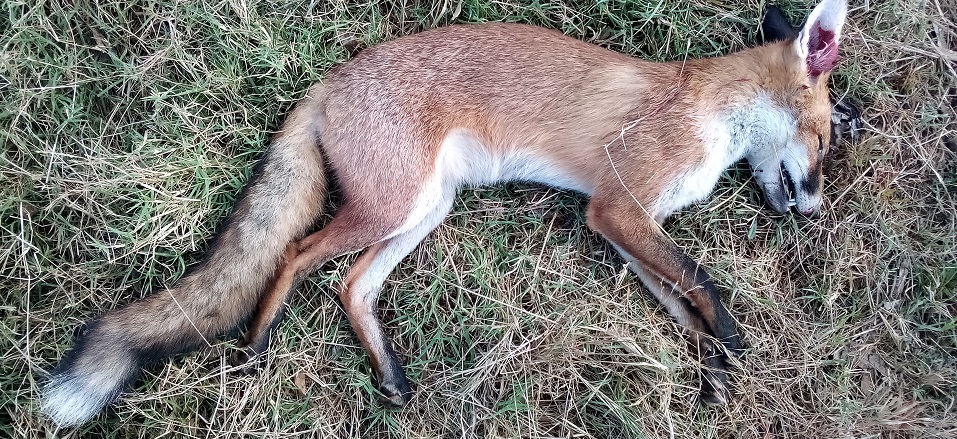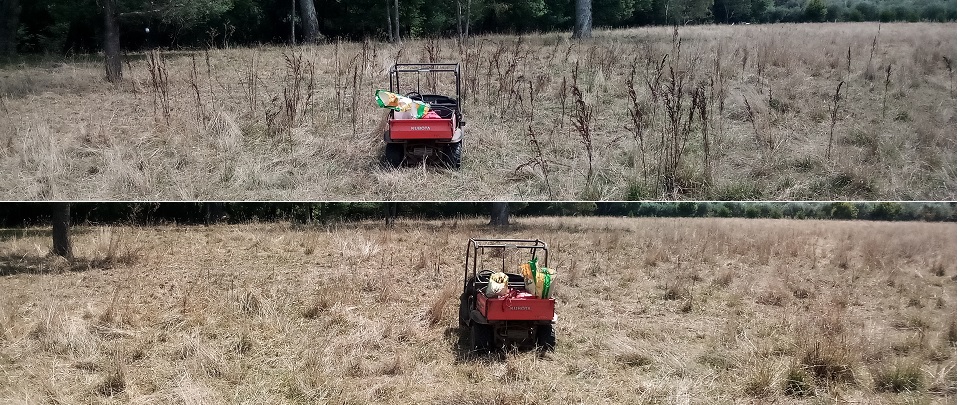Feral
For some reason I have never noticed this before, but most of my unwanted animal issues relate to feral animals. And this time of year is one of the peaks.
In the last few weeks we have been dealing with….cats, foxes, European wasps. Indian Mynah birds. Rabbits, rats. Dock, blackberries. Feral pests predate native animals and food, displace local species, breed up and expand their territory, bring in other pests and diseases. But you know all that…..!
Interestingly, our main nemesis, Lace Bug, is an Australian native that has jumped from the Australian Mock Olive. So, not a feral problem, unless you tie it into the fact that the olives are the introduced item! (In parts of Melbourne, along the Yarra River, olives are treated as an introduced pest!)
Foxes
I've posted about foxes before, and recently.
Two weeks ago I walked down to the bottom olive paddock in the middle of the morning. Not something I normally do in the daily schedule. I surprised three almost-adult fox cubs, who were wrestling in the dead space down by the river in the large commercial hop farm next door. They took off, of course, as soon as they were aware of me. I have been seeing more and more fox scat around the houseyard, so they have been in close at night.
But co-incidentally, I had just read a post by someone who had successfully trapped a fox. Her technique included….
1. A fox-specific trap. It has a long length and large opening. Dimensions are almost twice that of the more common possum/cat trap. The switch-mechanism is a flat plate in the floor of the cage. (It is heavy…16kg. But solid.)
2. Minimal human scent. She wore gloves to handle the cage and surrounds.
3. Dragline: The bait was dragged along the ground to create a trail to the cage
4. Camouflage: The cage was embedded in a haystack. Hay on each side, in top and on the floor of the trap. It looks like a hole in the haystack.
I followed her lead, bought the same cage online via ebay. Two days later I was set up, and…it worked! One juvenile fox. I have since reset it, rebaited, moved it. I am not expecting to catch another one soon.

Having said that, the hop farm next door has just completed their harvest. Up until that point the foxes use the huge area under hops as their territory. Now its all gone, and I can see to the horizon, almost! With no shelter remaining I expect we will see animals moving into our place. So I will keep the trap going.
Cats
Cats are an eternal issue. I've lost count of how many cats we have removed from the property. Generally the ones we see are skinny, diseased and not thriving, but some of them are fighting fit and very large and aggressive. The ones who are flourishing not caught very often. Two of them in eight years. The manky ones who are doing badly are more commonly caught, as the food in the cage overwhelms their caution. From now on I will apply the same strategies for cloaking the cage as we did for the fox cage. There's definitely at least two in the area at the moment…they woke us up fighting a few nights ago.
Rats
Part of the reason the cats are around is that they hunt rats. I have no idea how successful they are at that. Our rat population is a constantly bubbling number. I regularly set traps, and change the type of trap often. Its quite clear the rats work out how the trap mechanism behaves and develop strategies to get around it. For example, one trap has a snaplatch. But the latch is inside the trap….I often find that trap has been sprung, but the latch has been lifted up and then the door pushed open. I have to do something like put a balanced weight leaning against the door so it blocks it shut when the door closes, or balance the cage above a bucket so it drops into the bucket when the trap goes off. Each time I get it working, a new twist is added and we start again. Its an arms race!
Baits are good for getting rid of rats, but I am wary of secondarily poisoning, say, owls, kookaburras or my dogs. Recently we tried a bait that bio-degrades rapidly, and notionally is safe for the animals that predate rats. That's been quite successful…but they no longer are taking those baits. I need a new schtick.
Wasps
Oh, how I dislike European wasps! So far I've knocked out 6 nests this year. Initially I thought we were in for a good run. The first two nests discovered this year were in quite inhospitable soil. Mining spoil, mostly stone with a small amount of dirt filling the gaps. Not a premium location to set up a nest. And not something I have seen before. It made me think that the only successful nests this year were in dry locations. With so much rain over spring, perhaps the usual spots along the river had been washed out?
No such luck. I've since found another four nests along the riverbank. The progress of the nests is definitely later this year. For example, they are usually at peak aggression/annoyance at the time our grapes ripen, and picking the grapes is risky. Not this year. Bu the days are ticking over quickly, and the nests will become more aggressive shortly. I have one more difficult nest to deal with, at the moment. Difficult because its in the mouth of a wombat burrow. I can see the wasps flying in and out, but cannot work out the angle of the nest. I've had a couple of goes at spraying the nest, but clearly haven't got it right.
Rabbits
One year the rabbits got away from us, and at one stage there were at least 50 on our property. But most years they follow a similar trajectory….start building up over summer, peaking at the end of summer/start of autumn. At that point they start getting diseased…myxomatosis and calicivirus wipe them out.
We are at that point now. In the last two weeks I have seen, or found, half a dozen dead or dying rabbits, and I haven't seen any live ones now on our place for a week.
Indian Mynah Birds
A couple of years back I spotted two Indian Mynahs on our property. I tried a cage/trap, but I only caught two Australian Crested Pigeons. It’s a live-trap cage, so I was able to release them unharmed, but I didn't repeat the exercise.
The Mynahs have thrived. This year they have shown up in a flock of as many as 18.
A couple of weeks ago Landcare posted about Mynah bird traps. I got in touch and they have provided their trap, and a bit of guidance. Oddly, just at that point the Mynahs disappeared and I didn't see them for a couple of weeks. (And the same story in nearby Buckland Valley.) My theory is they went down the road to the large grape orchards with a ripening crop. Yesterday the grape crop started getting harvested, and there are lots of people working in the field amongst the vines. Today the Mynahs are back…along with 200 Starlings!
But, success! We have trapped some of them, and I am working with the Landcare chap to see if we can make an impact on the group.
Blackberries
Blackberries have been discussed in detail previously. As an update….the treatment of the top olive paddock is showing great results so far. Much more than half the blackberry plants are dying. I will leave the systemic poison we used to work its magic for as long as possible before we mow: I have to mow before the harvest at the end of May. I fully expect to see blackberry-free areas in this paddock next year. They'll be back, of course, each year for awhile yet, but eliminating one-offs is a lot easier than solid blankets of plants.
And dock….
Most farms have dock, as a weed. I've read the seeds are viable for 50 years, and each plant certainly produces thousands of seeds. It would be easy to lose a whole paddock to dock.
For us, we have nice timing…usually we cut our hay before the dock seeds form. Some of the leaf matter finishes up in our hay, which isn't great (but that's what happens). But this year we couldn't get the hay cut, so the dock went on to produce finished seed. Its been bugging me and bugging me, so a couple of weeks back I trudged through our hay paddock with bags and hand-cut the seed heads and bagged them up. They are sitting under shelter waiting for the time of year when its ok to burn prunings. At that point the dock seeds will go on the bonfire.

Before and after removal of dock seed.
Our other repeat-offender weeds are thistle, in its many forms, and Spurge. While it would be untrue to say we have eliminated these weeds, it’s a rare event to find one doing well in any of our paddocks. (Having said that, there's a couple of escapee thistles that I found along the river that have successfully disbursed their seed. I will be paying for that for years!)
